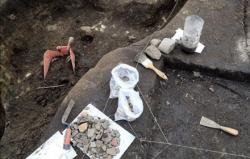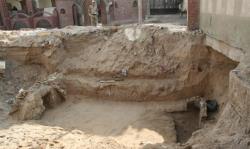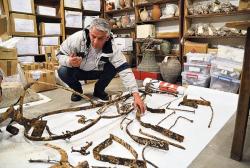INSTITUT SUPERIEUR D'ANTHROPOLOGIE
INSTITUTE OF ANTHROPOLOGY
ONLINE COURSES / COURS A DISTANCE
WINTER TERM : JANUARY 2014
REGISTER NOW
COLOMBIE –  Soacha - Some 170 archaeologists and workers have spent the last year excavating a 3,000-year-old site in a rural area near the Colombian capital. Covering 7.8 hectares (19.25 acres), the dig is “unique in Colombia” in terms of offering the possibility of reconstructing ancient village life, archaeologist John Gonzalez told Efe. “The site is the result of the New Hope electricity project. We came here basically due to the need for an environmental impact study,” explained Gonzalez, archaeological coordinator for EPM, one of the companies involved in the power project. EPM and Codensa, a subsidiary of Spain’s Endesa, expect to start construction at the end of next year on two electrical substations in the Bogota suburb of Soacha. In the meantime, the two firms are carrying out the archaeological excavation under the supervision of the official Colombian Institute of Anthropology and History. “We have found an archaeological context that tells us about a probable form of village life, with some traces of family dwellings,” Gonzalez said. “We also find structures of a ceremonial type of nature and funerary structures.” The site has yielded 30 intact ceramic objects as well as human bones and teeth. The materials reveal that the inhabitants were members of the so-called Herrera culture, who lived in the highlands of central Colombia from around 900 B.C. to A.D. 900.
Soacha - Some 170 archaeologists and workers have spent the last year excavating a 3,000-year-old site in a rural area near the Colombian capital. Covering 7.8 hectares (19.25 acres), the dig is “unique in Colombia” in terms of offering the possibility of reconstructing ancient village life, archaeologist John Gonzalez told Efe. “The site is the result of the New Hope electricity project. We came here basically due to the need for an environmental impact study,” explained Gonzalez, archaeological coordinator for EPM, one of the companies involved in the power project. EPM and Codensa, a subsidiary of Spain’s Endesa, expect to start construction at the end of next year on two electrical substations in the Bogota suburb of Soacha. In the meantime, the two firms are carrying out the archaeological excavation under the supervision of the official Colombian Institute of Anthropology and History. “We have found an archaeological context that tells us about a probable form of village life, with some traces of family dwellings,” Gonzalez said. “We also find structures of a ceremonial type of nature and funerary structures.” The site has yielded 30 intact ceramic objects as well as human bones and teeth. The materials reveal that the inhabitants were members of the so-called Herrera culture, who lived in the highlands of central Colombia from around 900 B.C. to A.D. 900.
http://www.hispanicallyspeakingnews.com/latino-daily-news/details/experts-excavate-remains-of-3000-year-old-structures-found-in-colombia/28294/
ROYAUME UNI - Damerham -A sink hole discovered by archaeologists in Damerham may hold vital information about the plant species thriving there 6,000 years ago.,,An archaeology team led by a Kingston University academic has been working on the Neolithic site for six years. Four areas of the temple complex were excavated during the summer, and in the largest of the openings, which was about 40 metres long, careful extractions revealed a layer of uncharacteristic orange sand and clay. Usually the archaeological survey would involve mapping and cataloguing finds such as bone, pottery and tool-making waste fragments. Instead the team, led by Dr Helen Wickstead, found plant remains. Dr Wickstead said the find was completely unexpected and had initially confused the team digging on the farmland. She said: “The site at Damerham is on chalk land, so we don’t often find materials like this that capture and preserve the plant remains from a specific time period.” It was evident that prehistoric people living in the area had also come across the sink hole and excavated the material during their own construction work. A pile of matching waste material was also seen at one of the other mounds. The prehistoric temple complex at Damerham is unusual because of the number of different structures in one area. Dr Wickstead added: “The diversity of burial architecture here is intriguing. What is special about this place that meant generation after generation returned to the site?” A variety of scientific techniques, including geophysical imaging which uses electrical currents to test the density of materials below the surface, have been used.Evidence of archaeological remains at Damerham was first detected in 2003, when English Heritage’s senior aerial survey investigator Martyn Barber spotted crop marks in a photograph. The different colours visible in the crops indicated there were historical earthworks just beneath the soil and Dr Wickstead teamed up with Mr Barber to begin the long process of trying to find out more about the site. Dr Wickstead said: “Doing the dig is only a tiny portion of the work required to document these important sites, but it is the more urgent part because erosion by farming and other environmental factors will gradually diminish what’s there.” She added: “This will help tell us more about how the people of this period lived and died in Damerham more than 6,000 years ago.”
http://www.salisburyjournal.co.uk/news/newforest/news/10870621.6_000_year_old_vegetation_found/
POLOGNE –  Holy Cross Mountain -An extensive water collection, the oldest parts of which date back to the 17th century, uncovered archaeologists in the close of the monastery on the Holy Cross Mountain. According to scientists, the discovery sheds new light on ways the monks coped with water shortages in the past."As part of the research we explored the grounds of the monastery close, courtyard surrounded by 15th-century cloisters" - told PAP Dr. Hadamik . In the central part there is a stone lining, at first glance looking like a well. "In fact, it is the upper part of a vast cistern underneath the courtyard. The lining itself is based on four stone pillars" - he explained. " The bottom of the reservoir is based on the solid rock. The chamber was dug in weathered rock" - said Hadamik who went down into the interior of the cistern. The reservoir collected mainly rainwater and groundwater. " It was probably built during the monastery renovations conducted by abbots Bogusław Raduszewski and Stanisław Sierakowski. It was a reservoir with dimensions of approximately 4.5 by 5 m, located 5.3 m below the courtyard surface. It is tightly enclosed with stone and rubble on all sides"- explained Dr. Hadamik. This is the first part of the system, which was intended to provide sufficient water for dozens of residents of the monastery and for the needs of the "paradise garden" maintained by monks in the close. "Later , in the 18th or early 19th century, auxiliary brick reservoir was built on the eastern side, with the bottom measuring 1.2 by 2 m, 1.3 m high in the highest point" - he said. The more recent chamber was connected to the main tank with a channel, "on the principle of communicating vessels" - said the archaeologist. According to calculations by the researcher, the system could hold about 35 cubic meters of water for the needs of the monastery. He estimated that it was sufficient to survive longer periods of water scarcity and drought.
Holy Cross Mountain -An extensive water collection, the oldest parts of which date back to the 17th century, uncovered archaeologists in the close of the monastery on the Holy Cross Mountain. According to scientists, the discovery sheds new light on ways the monks coped with water shortages in the past."As part of the research we explored the grounds of the monastery close, courtyard surrounded by 15th-century cloisters" - told PAP Dr. Hadamik . In the central part there is a stone lining, at first glance looking like a well. "In fact, it is the upper part of a vast cistern underneath the courtyard. The lining itself is based on four stone pillars" - he explained. " The bottom of the reservoir is based on the solid rock. The chamber was dug in weathered rock" - said Hadamik who went down into the interior of the cistern. The reservoir collected mainly rainwater and groundwater. " It was probably built during the monastery renovations conducted by abbots Bogusław Raduszewski and Stanisław Sierakowski. It was a reservoir with dimensions of approximately 4.5 by 5 m, located 5.3 m below the courtyard surface. It is tightly enclosed with stone and rubble on all sides"- explained Dr. Hadamik. This is the first part of the system, which was intended to provide sufficient water for dozens of residents of the monastery and for the needs of the "paradise garden" maintained by monks in the close. "Later , in the 18th or early 19th century, auxiliary brick reservoir was built on the eastern side, with the bottom measuring 1.2 by 2 m, 1.3 m high in the highest point" - he said. The more recent chamber was connected to the main tank with a channel, "on the principle of communicating vessels" - said the archaeologist. According to calculations by the researcher, the system could hold about 35 cubic meters of water for the needs of the monastery. He estimated that it was sufficient to survive longer periods of water scarcity and drought.
http://www.naukawpolsce.pap.pl/en/news/news,398333,archaeologists-discovered-17th-century-water-collection-systems-on-the-holy-cross-mountain.html
CHINE – Jingdezhen - Archaeologists have excavated a dragon kiln over 1,200 years old in Jingdezhen, once the center of China's ceramics industry, in the eastern province of Jiangxi.,The Tang Dynasty (618-907) kiln is 78.8 meters long and is the longest ever found from that period, according to Xu Changqing, head of Jiangxi cultural relics and archaeological institute. The kiln, in the ruins of Nanyao Village, was unearthed by a team from Xiamen, Northwest and Nankai universities and Leping City, between March and November, Xu said at a press conference on Monday. Dragon kiln is a long, sloping chamber, with a firebox at one end and a flue at the other. Dozens of tonnes of tools and ceramic fragments were also found at the ruins which cover around 1,000 square meters, said Zhang Wenjiang, a researcher with the institute.,The ruins were first discovered in 1964, but not excavated as conditions for preserving unearthed relics were very poor back then. In recent years, during debate as to precisely when Jingdezhen started firing porcelain, it was decided to examine the Nanyao ruins.
http://www.globalpost.com/dispatch/news/xinhua-news-agency/131210/ancient-dragon-kiln-unearthed-china
EGYPTE –  Al-Qantara -At the Roman necropolis in Al Qantara East the Egyptian mission of the Ministry of State of Antiquities (MSA) uncovered two Ptolemaic tombs that can be dated to the first century AD. MSA Minister Mohamed Ibrahim told Ahram Online that the first tomb belongs to a priest called Mina from a Roman area named Sila. The tomb is 6.5 meters high and 2.5 meters long. It is built of mud brick and has a vaulted ceiling and a burial shaft. One of the tomb’s walls is decorated with coloured paintings depicting Mina in front of the goddess Isis. The second tomb, according to Ibrahim, is built of limestone but still not yet identified. It contains a collection of Ptolemaic clay pots and pans. Mohamed Abdel Maqsoud, head of the Ancient Egyptian Section in the MSA, said that the necropolis was subjected to illegal excavation, but the Ismailiya police caught the culprits. He also added that the illegal excavation forced the ministry to immediate begin its own excavation there. Al-Qantara East has a rich history, dating back to the pharaonic era. Ahmose I, a pharaoh who founded the 18th century, waged many important wars in the area, most notably against the Hyksos, Seti, and Ramses II.
Al-Qantara -At the Roman necropolis in Al Qantara East the Egyptian mission of the Ministry of State of Antiquities (MSA) uncovered two Ptolemaic tombs that can be dated to the first century AD. MSA Minister Mohamed Ibrahim told Ahram Online that the first tomb belongs to a priest called Mina from a Roman area named Sila. The tomb is 6.5 meters high and 2.5 meters long. It is built of mud brick and has a vaulted ceiling and a burial shaft. One of the tomb’s walls is decorated with coloured paintings depicting Mina in front of the goddess Isis. The second tomb, according to Ibrahim, is built of limestone but still not yet identified. It contains a collection of Ptolemaic clay pots and pans. Mohamed Abdel Maqsoud, head of the Ancient Egyptian Section in the MSA, said that the necropolis was subjected to illegal excavation, but the Ismailiya police caught the culprits. He also added that the illegal excavation forced the ministry to immediate begin its own excavation there. Al-Qantara East has a rich history, dating back to the pharaonic era. Ahmose I, a pharaoh who founded the 18th century, waged many important wars in the area, most notably against the Hyksos, Seti, and Ramses II.
http://english.ahram.org.eg/NewsContent/9/40/88863/Heritage/Ancient-Egypt/Two-Ptolomaic-tombs-uncovered-in-AlQantara-East.aspx
SERBIE –  Stanicenje - During the protective archaeological works, carried out in parallel with the construction of Corridor 10, archaeologist Zoran Mitic found the remains of beautifully decorated chariot, assumed to be aged between 3,000 and 4,000 years and to have belonged to a Thracian from the elite of the time. According to Mitic, this an unique and extremely important item, which he found near the village of Stanicenje. “This is a chariot, drawn by two horses. My assumption is that the chariot belonged to a Thracian citizen,” Mitic told Tanjug. He said that this is backed by the fact that, at the location where the chariot was found, was also found a tumulus – a tomb. “Judging by the manner of burial, I guess that it was a member of Thracian people, not ordinary, but someone who occupied an important place in the hierarchy, due to the fact that the chariot is decorated with beautiful bronze applications,” he said.
Stanicenje - During the protective archaeological works, carried out in parallel with the construction of Corridor 10, archaeologist Zoran Mitic found the remains of beautifully decorated chariot, assumed to be aged between 3,000 and 4,000 years and to have belonged to a Thracian from the elite of the time. According to Mitic, this an unique and extremely important item, which he found near the village of Stanicenje. “This is a chariot, drawn by two horses. My assumption is that the chariot belonged to a Thracian citizen,” Mitic told Tanjug. He said that this is backed by the fact that, at the location where the chariot was found, was also found a tumulus – a tomb. “Judging by the manner of burial, I guess that it was a member of Thracian people, not ordinary, but someone who occupied an important place in the hierarchy, due to the fact that the chariot is decorated with beautiful bronze applications,” he said.
http://inserbia.info/news/2013/12/serbian-archaeologist-finds-4000-year-old-chariot/